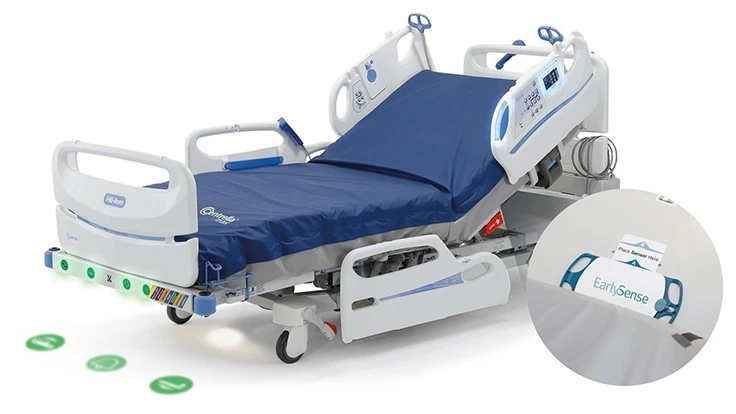
Photo courtesy of Hill-Rom & EarlySense
Hill-Rom, a global provider of medical technologies and the world's leading hospital bed manufacturer, today announced that EarlySense, the market leader in contact-free continuous monitoring solutions across the care continuum, has integrated its continuous contact-free heart rate and respiratory rate sensing and analytics technology into Hill-Rom's Centrella Smart+ bed platform.
The Centrella bed, which offers optimized patient safety, enhanced patient satisfaction and advanced caregiver-focused technology, now allows for continuous monitoring of patients' heart and respiratory rates over 100 times per minute without ever touching the patient. EarlySense technology alerts clinicians to potential patient deterioration events much earlier than traditional monitoring methods, enabling health teams to intervene and avoid "failure to rescue" scenarios more effectively.
Specific improved clinical outcomes demonstrated with this technology include helping reduce mortality related to "code blue" events by 83%1, and cardiac arrests by 86%.2 In addition, clinicians reported overall hospital length-of-stay was reduced by 9%2, and ICU days by 45%.2 Several EarlySense customers have reported that the system also assisted with early detection of sepsis, a condition that, when not identified and treated rapidly, may be life-threatening.
"Hill-Rom's Centrella bed is transforming inpatient care by integrating advanced sensing and analytics into the bed, offering a complete patient safety platform to assist clinicians in providing the highest level of care," notes John Groetelaars, president and CEO of Hill-Rom. "EarlySense has been used to effectively monitor close to a million patients, positively affecting patient outcomes. By integrating the EarlySense technology into our Centrella beds, we are ushering in a new era in quality of care, whereby all patients can be continuously monitored throughout their entire hospital stay."
"No patient should deteriorate without prior warning in the hospital environment. Continuous vital signs measurement should be the standard of clinical practice in the United States," says Dr. Frank Overdyk, a Charleston, SC-based anesthesiologist and expert on respiratory compromise. "Events such as opioid-induced respiratory depression and loss of life from failure-to-rescue are no longer acceptable given the availability of continuous vital signs monitoring."
"We are proud to be Hill-Rom's exclusive bed integration and nurse call communication partner, making our sensing and analytics technology available for more hospital patients and ensuring timely, effective clinical intervention is achieved," notes Avner Halperin, co-founder and CEO of EarlySense. "Integrating EarlySense monitoring capabilities with the Hill-Rom Centrella bed platform will advance our collective aspiration of having every patient in every hospital continuously monitored for safe, data-driven care, with the potential to save thousands of lives and significant costs for the healthcare system."
- White MD, "Early Detection of Patient Deterioration Using Novel Monitoring System," results presented in ASCIP Conference, 2015.
- The American Journal of Medicine. March 2014, Volume 127, Issue 3, Pages 226–232.
Latest from Today's Medical Developments
- Arcline to sell Medical Manufacturing Technologies to Perimeter Solutions
- Decline in German machine tool orders bottoming out
- Analysis, trends, and forecasts for the future of additive manufacturing
- BlueForge Alliance Webinar Series Part III: Integrate Nationally, Catalyze Locally
- Robot orders accelerate in Q3
- Pro Shrink TubeChiller makes shrink-fit tool holding safer, easier
- Revolutionizing biocompatibility: The role of amnion in next-generation medical devices
- #56 Lunch + Learn Podcast with Techman Robot + AMET Inc.





